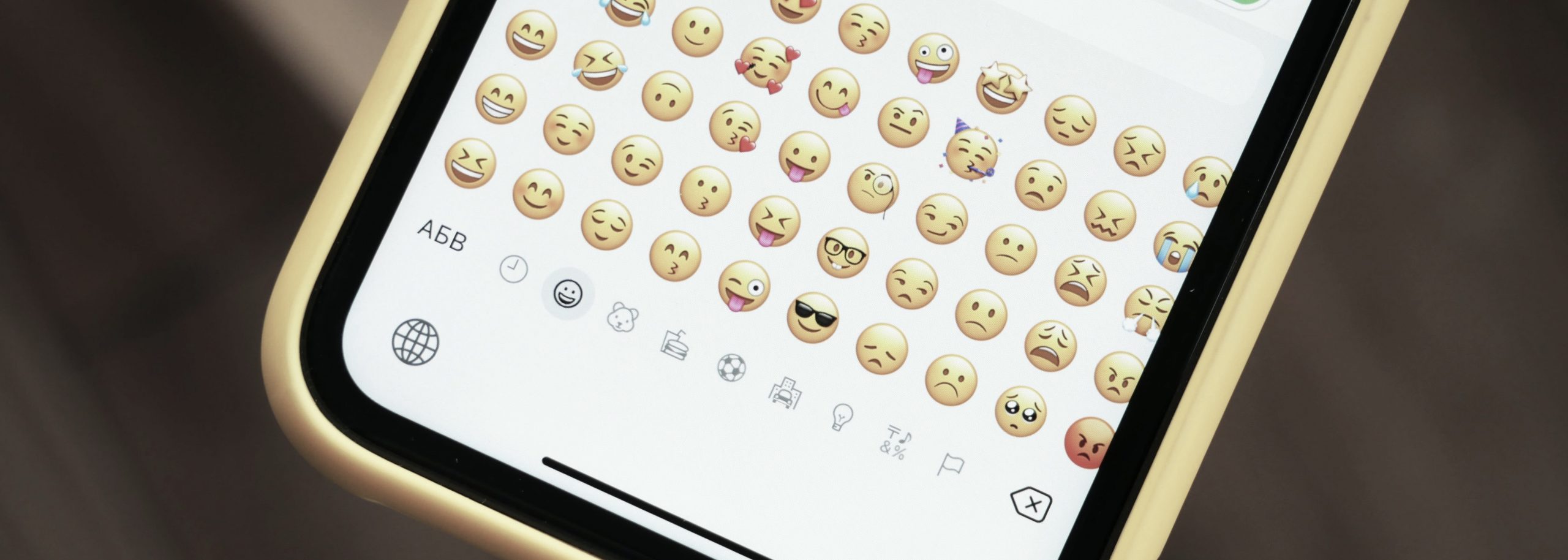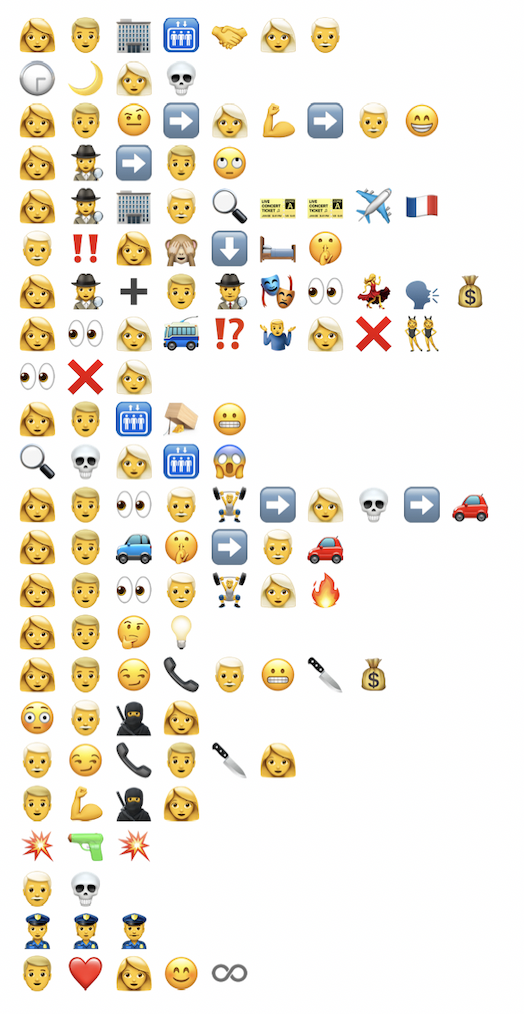Emoji story

Title:

Plot:
When I got my first email address as a pre-teen, I was not strong at typing quickly without errors. Thankfully, as mobile phones became more popular, we started incorporating short form (e.g., gr8, brb, l8r, etc.) in our emails, instant messaging, and texting. After quickly learning how messages can be misconstrued, my friends and I were careful about adding in emojis using keyboard symbols (e.g., =), ;-), :p, <3, etc.). With the new updated emojis on messaging applications and phones, we happily started incorporating those instead. This is around when Kress (2005) wrote that “writing is giving way, is being displaced by image in many instances of communication where previously it had held sway” (p. 5). Although I remember adding in emojis, I can not say that I personally used them in lieu of text. I have never used emojis with the intention of having them convey meaning. For example, I would say “I went apple picking *apple* *smile*” rather than “I went *apple* picking.” Although my use of shorthand and emojis has declined over the years when it comes to communicating informally, when new emojis come out, I happily look through them. When it comes to messaging friends, I use emojis to clarify my current emotion or to make my messages lighthearted. I was intrigued by Bolter’s (2001) statement about how it would be “interesting to speculate how photography, film, television, and multimedia might have been developed and used, if Western culture could somehow have jumped over the technology of printing and gone directly from medieval iconography to photographic and electronic visual presentation” (p. 55). Perhaps we would rely solely on images to communicate rather than written words, but, then again, maybe we would not have had the same pressure to create platforms with an abundance of information because, although images do have the power to portray meaning, they lack the ability to share information as is without the flexibility of different interpretations (Bolter, 2001).
Reflection:
I had a lot of fun scrolling through the emojis at my disposal and deciding which ones would best convey what I wanted to say. There were a few times where I could not find an emoji I thought existed and times where I wanted to use a word I knew could not be expressed as an image. Throughout this exercise, Kress’ (2005) statement rang true, that “meaning in language is clear and reliable by contrast, with image for instance, which, in that same commonsense, is not solid or clear” (p. 8). In the same way that written words can remove the emotion conveyed in spoken word, writing in emojis removes the intricacies of written sentences. I could not substitute words such as ‘unfortunately’, ‘but’, ‘then’, etc., which meant that I had to come up with a different perspective on how to express the storyline. Interestingly, although I felt that this form of electronic literature limited my expression in terms of syntax and grammar, it is also said that, as electronic literatures evolve, they develop their own grammatical structures and syntax that are solely seen in the digital world (Hayles, 2003).
Did you rely more on symbols, syllables, words, ideas, or a combination of all of them?
I used the emojis purely as symbols. I like the idea of syllables, but without being able to explain it, this becomes more challenging. In a game of charades, you have the advantage of being able to express ‘sounds like’ or try out different strategies if the interpreter does not understand. Writing in emojis, you only have one chance of creating something the audience will understand.
In Stern’s (2015) article in the Washington post entitled “How I Learned to Love Writing With Emojis,”Stern explains how, although “a small character can be a substitute for a word, or many words – similar to Chinese […] the language lacks the grammar, vocabulary, syntax and semantics of a true language” (para. 5). Replacing a word with a picture works really well when there is a picture for that word, but when conveying a longer story, this can become a bigger challenge. For example, an arrow pointing up could be perfect for the movie ‘Up’, but it could also be interpreted as ‘North’, ‘straight’, ‘above’ or even ‘on’, etc.
Although they are not at the same level, I could not help but think about symbolic languages like hieroglyphs and Chinese characters. Hayles (2003) explained how the pictures are both representations of words, but also of sounds which underlines just how complex hieroglyphs were. According to Wikipedia (List of writing systems, 2021), Chinese and Egyptian hieroglyphs are both logographic systems that represent morphemes or words. As I am only familiar with the “true alphabet” (List of writing systems, 2021) I am currently using, the complexity of reading both pictures and identifying the relationships between images and their corresponding sounds (Hayles, 2003) amazes me.
Did you start with the title? Why? Why not?
My first step was to create the title. I do not think there was a particular reason for this. Perhaps because I think of movies or books in order of ‘title’ then ‘plot’, or perhaps because I felt figuring out how to represent the title would be more challenging. The more emojis you use, the easier it is to convey what you mean to say. In a title, I felt that I should only use a few amount of emojis, perhaps one per word if possible. This limits options as I did not give space for extra emojis to help with interpreting the title. I followed my usual writing patterns, in the sense that I wrote left-to-right, starting up at the top of the page going down. Kress (2005) explained how order is fixed. “Order is firmly coded: the order of chapters, the order pages, of lines and of the line, and, of course, within lines as language, the order of syntax.” (p. 7). Although I was not able to follow the order of syntax in my plot, I was able to follow the order of lines on my page.
Did you choose the work based on how easy it would be to visualize?
I had several prerequisites for my title, following what was instructed on the task page. I wanted to choose a movie or book I had recently watched, something I remembered well, and I also didn’t want it to be too easy. I wanted to avoid anything too complicated as I wanted it to be possible to interpret. I ended up choosing a movie I watched recently with my brother and tested my emoji story on him to see if he could get it. Although he did not agree with all the choices I made in how to represent the story, he was able to guess the movie and follow the plot. I was happy that my emoji story proved to be successful, since, just as Stern (2015) expressed, when solely using emojis and no text, “the result can be complete and utter ambiguity, which is why most are confused by a string of characters sewn together” (para. 6).
Although I had fun exploring the world of emojis, I do see the benefits of being able to write out my thoughts more exactly. It is curious to think of how, in some situations, a picture may be worth 1000 words, portray more emotions, and offer more interpretations than words, however, words can be precisely selected to depict exactly what we mean to convey. “The attempt to make words do what pictures do might be taken to mean that pictures are primary and words secondary. However, earlier periods seemed more inclined to think that words were up to the task of bringing images under control” (Bolter, 2001, p. 56). Perhaps, embracing pictures, words, emojis and symbols allows us the best of every world, which is what we find in a several online resources today.
References
Bolter, J.D. (2001). The breakout of the visual. In Writing spaces: Computers, hypertext, and the remediation of print (2nd ed., pp. 47-76). Lawrence Erlbaum Associates. https://doi.org/10.4324/9781410600110
Hayles, K. (2003). Deeper into the machine: The future of electronic literature. Culture Machine, 5. http://svr91.edns1.com/~culturem/index.php/cm/article/viewArticle/245/241
Kress, G. (2005). Gains and losses: New forms of texts, knowledge, and learning. Computers and Composition, 22(1), pp. 5-22. https://doi.org/10.1016/j.compcom.2004.12.004
List of writing systems. (2021, October 17). In Wikipedia. https://en.wikipedia.org/wiki/List_of_writing_systems
Stern, J. (2015, May 19). How I learned to love writing with emojis. The Wall Street Journal. http://graphics.wsj.com/how-i-learned-to-love-writing-with-emojis/